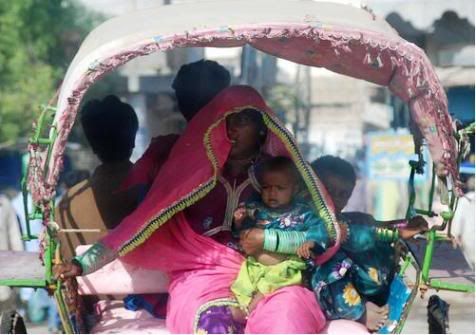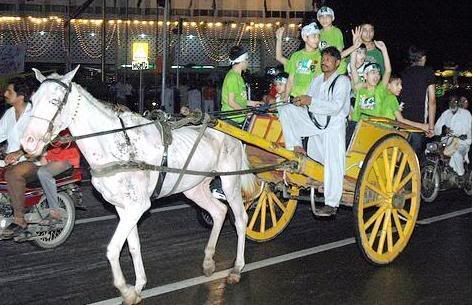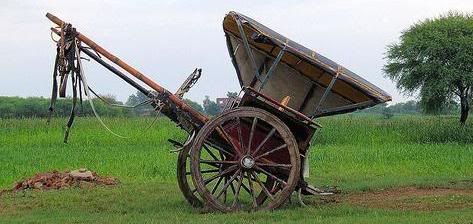Discussing Pakistan’s unique transport has remained a favourite topic at ATP (see Rickshaw, Truck, Tram, Bus and all modes of transport together in a post).
Today I want to pose a question to our readership. What do you think is the most challenging transport ride you’ve taken in Pakistan? If you ask me then there is only one possible answer and that is the challenge of sitting and not slipping at the back seat of a tonga.
You see the tonga owners all across Pakistan, for some reason, put a vinyl/plastic back seat cover. The urdu word for this material is mome-jaama. Now most of the tongas in Pakistan travel at a tilted angle anywhere between 30 degrees and 60 degrees. This tilt angle is directly proportional to the weight of back seat passengers and inversely proportional to the weight of coachman. To get a better picture, see this forward slash that I am going to type ( / ). Now imagine sitting on the back seat of a tonga at such a tilt, with a plastic seat cover underneath and not slipping. pretty tricky – huh.
The situation is even more challenging for children whose feet do not reach the foot board. I’ve had first hand experience of facing this serious challenge many times during my tonga rides from Lahore station to Misri Shah or do-moria-pul or on the inclines of old city Lahore.
One has to grab on to anything on a tonga’s frame for one’s dear life but if you are sitting in the center of the seat then there is no other option but to grab on to other people’s clothes to avoid slipping.
rau meiN hai rakhsh-e-umr, kahaaN dekhiye thamay
na hath baag par hai na paa hai rakaab meiN
As if this problem was not enough, imagine ladies holding small children in their laps and sitting on the back seat of a tonga.
I will refer our readers to the title photo of this post to appreciate this problem.
This situation is a 3-variable problem of dynamic motion. While the tonga moves forwards, the ladies keep slipping backwards and the babies in their laps also tend to slip backward but with a different acceleration. This is all because Newton once said that a=F/m where m is hugely different for mothers and babies. Therefore to over come Newtonian law and a Draconian seat, mothers have to be extra skilfull on a tonga.
If you think this is the end of a tonga’s back-seat dilemma then I will say three times in English: no, no and no and 3 more times in Urdu: na, na aur na. There is one more test reserved only for tonga’s back seat passengers. This happens when at a traffic light the tonga behind yours cannot stop in time (ghora bhi aakhir ko insaan hai – khataa ka putla hai – or atleast he is controlled by a human). In such cases the saliva foaming and smiling with green teeth face of a horse comes dangerously close to back seat passengers of front tonga. Imagine this situation in the graphics that I will type. It shows 3 tilting tongas and their horizontal horses. ( /horse3/horse2/horse1 ). Note how dangerously close horse 2 is to the back seat of tonga 1 and so on.
I’ve heard of real life situations where people in the back seat of a tonga ran away or screamed when the face of horse from the tonga behind them came too close.
This post is not an exaggeration. May be the tilt angle of a tonga ( / ) is a bit exaggerated but slipping on back seat of a tonga is very real and quite unique to this part of the world.
kis cheez ki kami hai khwaja teri gali meiN
GhoRa teri gali maiN, nathia teri gali meiN
I’ve even read this problem in Urdu literature. I believe I read it in late Ashfaq Ahmed’s one of zaavia series books.
Do you have any experience to share from a tonga’s slippery slope?
Photo Credits:
(1) Title photo is courtesy of Nida Shams
(2) n Bazmi
(2) Sir Cam





















































Years ago, when I used to be in elementary school we had a “school tanga”, much like a “school bus” and I have many fond memories of going to school on a tonga. As I have written here before, all I have written here before, I still see myself in the tanga metaphor at ATP”:
“Tangay waala khair mangda”
Adeel, yes I am very familiar with the water troughs at various places of the city to freshen the horses :)
I recently read an article on Karachi’s history where a few water troughs for horses still survive in Denso Hall and Trinity Church area which are from the 1800s. While they are not used anymore, people probably don’t even know they exist and what was their function.
Tonga transport is also going to be history soon and I have mixed feelings on whether it is a good thing or bad. Both I guess. CNG and Auto rickshaws will completely take over tonga industry, if not already.
Rizwan. You are right about ‘tongas’ being able to wade through lakes of rain water and several inches deep saturated mud and water filled pot holes (called ‘khoba’ and ‘toye’ in Punjabi?). A tonga is able to wade through these challenges because of large diameter of its wheels and ofcourse the horsepower.
I have been relieving this toga-riding experience over a period of time during my college going days. Since, I have been living in the same area about which owais sb hinted in this post. I would like to share another observation of mine that few slangs which were commonly uttered by the Kochwan Bradari (coachman fraternity) whilst driving the Tonga. For example they were used to say “ Hut ke Jawan” (move aside young man irrespective what age was of the person) and “Buch ke Baoe Jee” ( Be careful gentleman) when someone comes into their way. I remember this particular area was little below than the sewerage level. All the rain water was used to spread over the roads which would give the impression of a small lake. Not any transport would dare to travel in this area even on the double fare rates. Tonga was the only means of transportation available for the locals which would carry them to their destinations wading across the water on the roads.
Very nice, Owais. I spent my early childhood in Sialkot and a tonga was the most commonly available mode of transport. Naturally, I have fully experienced all the real-life situations you have described here.
Since I was a boy, I was expected to not be disturbed when the horse from the trailing tonga came too close. So while I tried to appear unflinched, I really was scared out of my skin (hey, I was under 10 years old). I can tell you, it was a real test of faith. And the weak among us, do run off screaming :-)
I also remember, we used to have these watering holes for horses (essentially large tubs made of cement) at various spots around the town where tonga drivers, to the dismay of on-board passengers, would occasionally stop to ‘freshen up’ their horses.
Another thing I would like to share is a bit of tonga terminology. The side bars on the frame were locally referred to as ‘bumb’ (lit. bomb – not sure if the term is used in other cities/regions as well), due to their resemblance to rockets/missiles. I heard of many unfortunate accidents where on coming riders collided with these bars and sustained serious injuries… especially during the night.